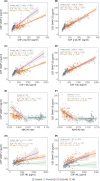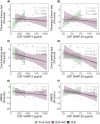Evaluation of cerebrospinal fluid levels of VAMP-2 and SNAP-25 in a dementia with Lewy bodies clinical cohort stratified by Alzheimer's pathophysiological biomarkers
- PMID: 39994784
- PMCID: PMC11849174
- DOI: 10.1186/s13195-025-01685-y
Evaluation of cerebrospinal fluid levels of VAMP-2 and SNAP-25 in a dementia with Lewy bodies clinical cohort stratified by Alzheimer's pathophysiological biomarkers
Abstract
Background: Synaptic protein levels in cerebrospinal fluid (CSF) may represent much-needed objective biomarkers of cognitive impairment, disease progression and drug efficacy in patients with dementia with Lewy bodies (DLB). Soluble N-ethylmaleimide-sensitive factor attachment proteins receptors (SNARE) proteins, such as VAMP-2 and SNAP-25, are implicated in α-synuclein pathophysiology and CSF levels of these proteins are associated with pathophysiological biomarkers and cognitive decline in Alzheimer's disease (AD). The aim of the study was to compare CSF levels of VAMP-2 and SNAP-25 in patients with DLB to cognitively unimpaired controls and AD patients and study their association with cognitive performance and AD and neurodegeneration biomarkers.
Methods: VAMP-2 and SNAP-25 were quantified in CSF from cognitively normal controls (n = 62), DLB (n = 44) and AD (n = 114) patients from the Sant Pau Initiative for Neurodegeneration (SPIN) cohort using homebrew Single Molecule Array assays (Simoa). The DLB group was stratified into two groups with ("DLB + AD", n = 28) or without AD co-pathology ("pure DLB", n = 16) using our validated cut-off for the CSF phosphorylated tau (p-tau)/Aβ42 ratio. We used linear regression to test for group differences (adjusting for age) and association with AD biomarkers. We used standardized w-scores of the cognitive tests to analyze the association of the synaptic markers with cognitive performance.
Results: CSF VAMP-2 and SNAP-25 levels correlated across all groups (r = 0.71-0.9, p < 0.001). Both proteins were decreased in pure DLB (p < 0.001, p = 0.01) but increased in DLB + AD (p = 0.01, p = 0.02) compared to controls and showed good accuracy to discriminate pure DLB from DLB + AD (AUC = 0.84, 0.85). Both proteins were associated with CSF p-tau and total tau (t-tau) across all groups (r2 = 0.49-0.88, p < 0.001), with the Aβ42/40 ratio in DLB + AD (r2 = 0.29-0.36, p < 0.001) and in AD (r2 = 0.12-0.23, p < 0.001) and with CSF neurofilament-light chain (NfL) in controls (r²=0.10-0.11, p < 0.001-0.01) and AD patients (r²=0.01-0.08, p = 0.01 - 0.001). SNAP-25 was associated with CSF NfL in the DLB + AD group (r²=0.15, p = 0.02). CSF VAMP-2 and SNAP-25 were associated with phonemic fluency in pure DLB (r2 = 0.39 - 0.28, p = 0.01-0.03) and SNAP-25 with the Clock drawing test and the MMSE in DLB + AD (adj.r2 = 0.15 - 0.14, p = 0.03-0.03) and DLB (adj.r2 = 0.12 - 0.08, p = 0.02-0.04) groups.
Conclusions: CSF VAMP-2 and SNAP-25 are promising surrogate markers of synapse degeneration in DLB. However, care should be taken when interpreting CSF levels of these synaptic markers in DLB in light of the confounding effect of AD pathophysiological markers.
Keywords: Biomarker; Cerebrospinal fluid; Dementia with Lewy bodies; SNAP-25; Synapse; VAMP-2.
© 2025. The Author(s).
Conflict of interest statement
Declarations. Ethics approval and consent to participate: This study was reviewed and approved by the IRB (Institut de Recerca de l’Hospital de la Santa Creu i Sant Pau– IIB Sant Pau) and was conducted in accordance with the Declarations of Helsinki. All participants gave their written informed consent to participate in the study. Consent for publication: Not applicable. Competing interests: E.V. is co-founder of ADx NeuroSciences NV, Zwijnaarde (Ghent), Belgium, J. G. is employee at ADx NeuroSciences NV. J.F. has served as a consultant for Novartis and Lundbeck, has received honoraria for lectures from Roche, NovoNordisk, Esteve and Biogen and served at advisory boards for AC Immune, Zambon and Lundbeck. D.A. participated in advisory boards from Fujirebio-Europe and Roche Diagnostics and received speaker honoraria from Fujirebio-Europe, Roche Diagnostics, Nutricia, Krka Farmacéutica S.L., Zambon S.A.U., Lilly and Esteve Pharmaceuticals. A.L. participated in advisory boards from Biogen, Eisai, Fujirebio-Europe, Novartis, NovoNordisk, Nutricia, Otsuka Pharmaceutical, and Zambón, and received speaker honoraria from Lilly, Biogen, KRKA and Zambon. D.A, J.F., A.L. and O.B. declare a filed patent application (WO2019175379 A1 Markers of synaptopathy in neurodegenerative disease) related to biomarkers included in this manuscript.
Figures



References
-
- McKeith I, Mintzer J, Aarsland D, Burn D, Chiu H, Cohen-Mansfield J, et al. Dementia with Lewy bodies. Lancet Neurol. 2004;3(1):19–28. - PubMed
-
- McKeith IG, Dickson DW, Lowe J, Emre M, O’Brien JT, Feldman H, et al. Diagnosis and management of dementia with Lewy bodies: third report of the DLB Consortium. Neurology. 2005;65(12):1863–72. - PubMed
-
- Calo L, Wegrzynowicz M, Santivañez-Perez J, Grazia Spillantini M. Synaptic failure and α-synuclein. Mov Disord. 2016;31(2):169–77. - PubMed
-
- Colom-Cadena M, Gelpi E, Charif S, Belbin O, Blesa R, Martí MJ, et al. Confluence of α-synuclein, tau, and β-amyloid pathologies in dementia with Lewy bodies. J Neuropathol Exp Neurol. 2013;72(12):1203–12. - PubMed
MeSH terms
Substances
Grants and funding
- AC21_2/00017/EU Joint Programme- Neurodegenerative Disease Research
- PI22/00611/Instituto de Salud Carlos III
- PI21/00327/Instituto de Salud Carlos III
- Program 1, Alzheimer disease/Centro de Investigación Biomédica en Red sobre Enfermedades Neurodegenerativas
- AGAUR 2019 PROD 00088/Agència de Gestió d'Ajuts Universitaris i de Recerca
LinkOut - more resources
Full Text Sources
Medical

